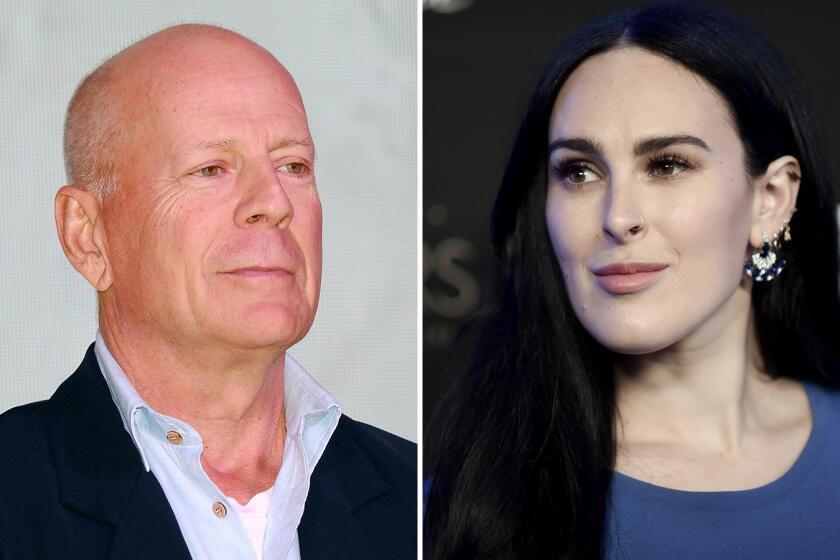COMMENTARY : BLOCKBUSTER CASHES IN ON CRASS SIDE OF SHOW BIZ
Multiple choice. Which of the following definitions most accurately describes the word blockbuster ?
a. The first minority family to buy into an all-white neighborhood.
b. A tombstone engraver.
c. A bomb.
d. A hit.
If you know the answer to that question, then you also know the name of Hollywood’s greatest blockbuster. No, not “E.T.”
“Heaven’s Gate.”
You can look it up. A blockbuster is “a very large destructive bomb that can devastate . . . a city block” (Webster’s Unabridged). Somehow, the word got turned around to mean any commercial entertainment that makes someone suddenly rich.
You could dismiss this as a word game, except that the film industry’s lust for the blockbuster--the propensity to damn the costs and the art to go for a smash commercial hit each time out--is giving off the faint aroma of a burning fuse.
“He who lives by the blockbuster will die by the blockbuster.”
The doomsday phrase belongs to producer Robert Radnitz, who makes the kind of movies (“Sounder,” “Cross Creek”) that are being squeezed out in the era of go-for-broke film making.
“I just look at the industry and I see it getting deeper and deeper into this thing that will consume it,” Radnitz says. “It’s depressing for anybody who really loves the business, who really loves movies, to see the studios spend all this money . . . trying to imitate hits instead of working with film makers who have vision and a passion for what they’re doing.”
(It may be argued that “Heaven’s Gate” was made out of passion, but the one clear message from “Final Cut,” Steven Bach’s gruesome autopsy of that movie, is that it was United Artists’ desperate longing for a hit that allowed Cimino to break the bank.)
The megahits of the last decade--$100-million babies like “Star Wars” and “Raiders of the Lost Ark”--have raised studio, investor and media expectations to such absurd heights that anything not clearly a smash is clearly a bomb.
This summer produced two $10-million hits (“Back to the Future” and “Rambo: First Blood Part II”), and six others that took in more than $40 million each. Yet, the season was treated like a death in the family.
“Pale Rider” and “Silverado” grossed nearly $80 million between them, a total that a few years ago would have caused a stampede of Westerns. In mega-wish 1985, the figures were not only disappointing, but have been taken as evidence that the Western was indeed a dead box-office critter.
Summer business was down dramatically this year, and the fall isn’t doing so well, either, causing alarmed analysts to blame everything from product glut to fickle fingers of fate. You’ll even hear a few studio execs acknowledge that the poor overall quality and look-alike nature of films this year has had something to do with it.
Psychologists say the best predictor of future behavior is past behavior. The studios, scraping cells off last year’s hits in attempts to clone next year’s, seem to agree.
Maybe this year’s box-office slump will convince them otherwise. As Radnitz says, give people less and they either learn to accept less or they go elsewhere. Many adult moviegoers have long since given up and gone elsewhere; now, the children are defecting.
Hollywood has always made more bad movies than good, but quality is no longer even much of a goal. Until recently, the studios routinely included a few “prestige” pictures in their annual lineups, figuring that, at the very least, Academy Awards helped them recruit the best film makers.
Today’s studio executives can’t afford to look that far ahead. They could be independent producers by March. The pressure is not to win awards, but to enhance dividends, so why take up important slots on the annual production schedule with films that, even though they may be profitable, stand little chance of being blockbusters?
Besides, if they decide they want an Academy Award contender, they can always pick one up from one of those quaint English outfits that keep churning them out.
The advent of pay TV, cable and videocassette markets has turned the film industry into a blue-chip casino for investors ranging from oil-soaked sheiks to common folk playing with their retirement funds. How much money can be made by one movie? $300 million? $400 million? Steven Spielberg can’t wait to find out.
Even studios in prolonged slumps are prized by money barons. If MGM/UA were a horse, it would be pulling a wagon somewhere. But even such a fine judge of horse flesh as Ted Turner has taken a look at its sway back and pronounced it a thoroughbred.
Ironically, the film industry, which survived the advent of TV in the ‘50s by offering entertainment TV could not, is becoming more like TV every day. That is partly because the post-theatrical life of a film (on TV, cable and tape) can generate half or more of its income. But mostly it’s because both media are programming for the largest common denominator.
The result is that people with new ideas--with more complicated story lines or with ambitions for developing characters--are being squeezed out of the production schedules. Their kind of movies, in a high-energy era where elders revere the young, may be going the way of poetry. There may be an audience out there, but don’t hold thy breath.
Radnitz says the only antidote for blockbuster fever is old-fashioned faith.
“Nobody can say a movie is going to work, that people will want to see it,” Radnitz says. “They have to go to a producer or a director or a writer who has a track record and say, ‘Here, run with the ball.’ In the final analysis, if we’re going to have movies that are worth anything, there is no other way.”
Radnitz may sound like someone trying to sell Duke Ellington records at a Black Sabbath concert, but he’s right. If Hollywood is going to continue to make movies, as well as hits, it needs to make room for people who know how.
Meanwhile, run for cover.
More to Read
Only good movies
Get the Indie Focus newsletter, Mark Olsen's weekly guide to the world of cinema.
You may occasionally receive promotional content from the Los Angeles Times.






